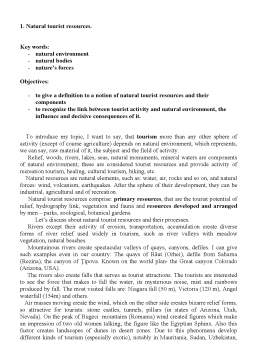Extras din referat
1. Natural tourist resources.
Key words:
- natural environment
- natural bodies
- nature’s forces
Objectives:
- to give a definition to a notion of natural tourist resources and their components
- to recognize the link between tourist activity and natural environment, the influence and decisive consequences of it.
To introduce my topic, I want to say, that tourism more than any other sphere of activity (except of course agriculture) depends on natural environment, which represents, we can say, raw material of it, the subject and the field of activity.
Relief, woods, rivers, lakes, seas, natural monuments, mineral waters are components of natural environment; these are considered tourist resources and provide activity of recreation tourism, healing, cultural tourism, hiking, etc.
Natural resources are natural elements, such as: water, air, rocks and so on, and natural forces: wind, volcanism, earthquakes. After the sphere of their development, they can be industrial, agricultural and of recreation.
Natural tourist resources comprise: primary resources, that are the tourist potential of relief, hydrography link, vegetation and fauna and resources developed and arranged by men – parks, zoological, botanical gardens.
Let’s discuss about natural tourist resources and their processes.
Rivers except their activity of erosion, transportation, accumulation create diverse forms of river relief used widely in tourism, such as river valleys with meadow vegetation, natural beaches.
Mountainous rivers create spectacular valleys of quays, canyons, defiles. I can give such examples even in our country: The quays of Răut (Orhei), defile from Saharna (Rezina), the canyon of Ţipova. Known on the world plan- the Great canyon Colorado (Arizona, USA).
The rivers also create falls that serves as tourist attractions. The tourists are interested to see the force that makes to fall the water, its mysterious noise, mist and rainbows produced by fall. The most visited falls are: Niagara fall (50 m), Victoria (120 m), Angel waterfall (154m) and others.
Air masses moving create the wind, which on the other side creates bizarre relief forms, so attractive for tourists: stone castles, tunnels, pillars (in states of Arizona, Utah, Nevada). On the peak of Bugeci mountains (Romania) wind created figures which make an impression of two old women talking; the figure like the Egyptian Sphinx. Also this factor creates landscapes of dunes in desert zones. Due to this phenomena develop different kinds of tourism (especially exotic), notably in Mauritania, Sudan, Uzbekistan, Australia. Natural landscapes of dunes form also on the shores of Baltic sea, and promote tourist flow in Poland, Latvia, Estonia, Kaliningrad.
In zones of shores and seacoasts waters create natural beaches. The most extended are: the beach in Rio de Janeiro called Copacabana, in Florida – Miami beach, Long beach, Beverly hills, in India – Mombay, in France Cote d’Azur, and others.
Fluvial tourism, cruises are practiced on Danube, Volga, Dnieper, Odra, Siena, Mississippi, Geneva lake, Ladoga, Caspian sea, Baikal, in North America on Manitoba, Winnipeg, Victoria, Chad.
Vegetation creates natural landscapes of forests, steppes, savanna; these are widely developed for hunting, safari, hiking and just for pleasure.
Natural tourist resources arranged and developed by men are represented by natural
reservations, national parks, botanical and zoological gardens. For example, such national parks as Serengeti (Tanzania), Cruger (South Africa), Corbet(India), Everest (Nepal), GrandParadisso (Italy), Retezat(Romania); natural reservations Juventas(Latvia), Sihotealin (Russia), Codru, etc.
So, the relations of tourism and nature environment are close and very significant. The tourist interest for tourist natural resources increase more if they are varied and complex, and particularly non-altered, ie with primary properties and as follows the activities that resources generates are more valuable and attractive.
Preview document
Conținut arhivă zip
- Tourist Resources and Tourist Potential.doc


















